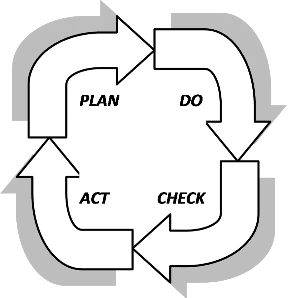Iso 20000 Continual Improvement Cycle Plan Do Check Act
In ISO 14001 it is relatively easy to see how the requirements of the standard follow the conventional improvement cycle of Plan-Do-Check-Act. This is an important concept in the world of process improvement, and the ISO organization has made it easier to see how the requirements of management system standards (such as ISO 9001) follow this cycle. With ISO 14001, it is easy to see this in the way that the requirements follow the plan-do-check-act cycle in order, as it is written in such a way that you can follow through the standard in order as you implement ISO 14001 in your organization.
For more details on Plan-Do-Check-Act and some information on how Plan-Do-Check-Act works in the ISO 9001 standard, see PDCA (Plan-Do-Check-Act) Cycle in ISO 9001 Requirements.

What are the basics of the Plan-Do-Check-Act cycle?
Plan-Do-Check-Act, which is also called PDCA, is a cycle for improvement that was originated and made popular by two of the fathers of modern quality control, Walter Shewhart and Edward Deming. The cycle is used when implementing a change in order to improve a process. A quick example would be when you try to reduce paper usage at your facility.
You Plan to reduce the paper usage by 10% in the first year; Do is when you use paper as you normally would, with some planned reductions such as asking people to print double sided; Check is when you compare your actual paper usage against the expected reduced paper usage (and you may find that you have only reduced your monthly usage by 5%); and the Act phase is when you decide how you will react – e.g., by setting the printers to default to double side unless changed or further educating workers on reducing paper usage by reading documents on the computer.
How is the Plan-Do-Check-Act cycle found in the ISO 14001 standard requirements?
While the above example is only for one segment of environmental management, the ISO 14001 requirements are organized in such a way so as to create your environmental management system (often called an EMS) in a PDCA format for all of your processes.
Plan. Starting with understanding the context of your organization and what the needs and expectations are of your interested parties (clauses 4.1 & 4.2). You can then determine what your EMS scope is (clause 4.3) and define your EMS (clause 4.4). You then need to identify your leadership commitment (clause 5.1, set your environmental policy (clause 5.2) to guide your EMS and identify the roles, responsibilities and authorities required for your EMS (clause 5.3).
Planning continues as you address the risks and opportunities within your EMS including how you interact with the environment and your legal compliance obligations (clause 6.1), as well as setting and planning to achieve environmental objectives for improvement (clause 6.2). The final stage of planning for the EMS involves support processes such as setting processes for assigning resources (clause 7.1), identifying competence requirements (clause 7.2) and what awareness is required (clause 7.3) within your EMS. The process for internal and external communication (clause 7.4) and creating and controlling documented information for the EMS (clause 7.5) complete these support processes.
Do. Clause 8 on operation goes into detail on what processes are important to establish and maintain in order to have a strong and successful EMS. The starting point is in establishing the operational controls (clause 8.1) needed to ensure that the processes of the organization can function in such a way that negative effects on the environment are controlled. The final step is to have the plans in place for emergency preparedness and response (clause 8.2) should anything actually go wrong.
Check. The entire next section of the ISO 14001 standard is entitled "performance evaluation" (clause 9). The methods of doing this are listed as monitoring, measurement, analysis and evaluation (clause 9.1), which applies to the key characteristics of the organization that can have significant impact on the environment as well as an evaluation of compliance.
The second method of checking included in the standard is the process for internal audits (clause 9.2), which is a systematic way to review the processes of the EMS to validate that they are meeting the planned arrangements that are set out for them. The final section of performance evaluation involves having management of the organization review the information collected in the checking processes; this is called management review (clause 9.3).
Act. The final section of the standard is titles "improvement". This section includes dealing with nonconformity and corrective action (clause 10.2) in order to fix problems found during performance evaluation. This activity is done in order to react to the information gathered and make any necessary adjustment to the plans for the EMS. If a target has been met, then a new target can be chosen. If there are problems reaching a target, then resources for the program can be reviewed and adjustments made. These activities are completed with requirements for continual improvement (clause 10.3) as a way to ensure the EMS improves over time. This Act phase allows the plans to be modified so that the cycle of improvement, Plan-Do-Check-Act, can start again.
How to use the PDCA cycle in your EMS
By employing the PDCA cycle on a process, you can work on improvements of that process for greater effectiveness. By realizing that this is in place for the entire EMS, you can use this to your advantage to improve the overall process of the environmental management system to reach greater effectiveness in protecting the environment and avoiding adverse environmental impacts. After all, environmental protection is the reason that an environmental management system is in place to begin with.
Source: https://advisera.com/14001academy/knowledgebase/plan-do-check-act-in-the-iso-14001-standard/
Publicar un comentario for "Iso 20000 Continual Improvement Cycle Plan Do Check Act"